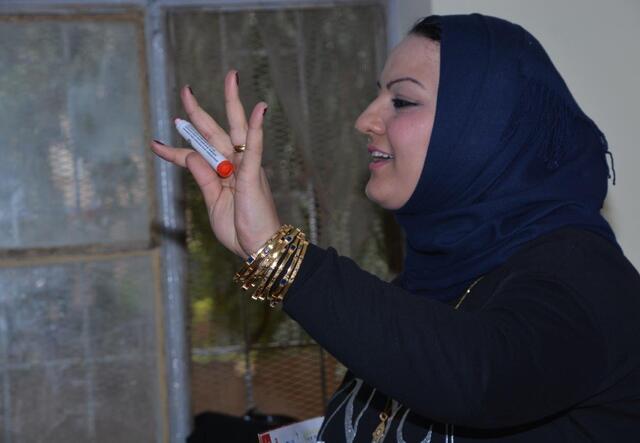Iraqi teacher creates safe haven for students displaced by war
Sinan, herself displaced by violence, created a safe spaces for refugee and displaced children in Iraq.
Sinan, herself displaced by violence, created a safe spaces for refugee and displaced children in Iraq.
Sinan Younis has relatively little experience in the classroom, and a daunting teaching load—few colleagues could even imagine controlling 70 students of varying ages in one room, and doing so twice a day.
But in Sinan’s classroom in the city of Erbil in Iraq, children eagerly tackle the math problems before them, or raise their hands politely to ask for help. They are refugees from Syria or internally displaced in Iraq, most starting over after being out of school for a year because of war, yet they appear attentive and ready to learn.
How does Sinan manage to maintain order in impossible conditions? She appeals to her students’ innate sense of play.
“I start by establishing rules inside the classroom,” she says. “We decide that if anyone does something not in the rules, the student will have to sing a song, or say a poem. They start to change, to have fun. Sometimes, all displaced students need from the teacher is safety.”
According to United Nations Children’s Fund (UNICEF), two million children in Iraq have no access to school due to war and displacement. Almost 14,000 teachers have fled northern Iraq to escape ongoing violence, creating a teacher shortage even as thousands of refugee children enter the school system.
Sinan is also starting over. She and her husband and two young children were forced to abandon their comfortable life in Mosul after ISIS invaded the city in 2014.
“In Mosul, I was a chemist with the government and worked in a laboratory,” she explains. Finding work as a chemist in Erbil proved difficult, so when Sinan saw people applying for teaching positions while she was enrolling her children in a newly opened school, she decided to do the same. She has been teaching math to elementary students since.

Schools in northern Iraq have taken in thousands of Syrian and Iraqi students who’ve endured gunfire, bombings and, sadly, deaths of family members. The need for trained teachers to support these traumatized children and manage overcrowded classrooms is great. For students displaced by conflict, teachers can be a stabilizing, even lifesaving, force, especially those who know the horrors of war firsthand.
Sinan is part of the International Rescue Committee’s Healing Classrooms initiative, which trains educators in teaching techniques that help students in conflict zones to feel safe and to learn. Over 800 teachers have completed the training in northern Iraq.
“It was an amazing course—it changed the way I deal with students,” says Sinan. “Now I do activities and games to break the ice. I divide the classroom into groups and create competitions with prizes.”
Before the IRC introduced its Healing Classrooms initiative to the school, students lacked adequate books and supplies and they were forced to sit on bare floors even in the winter. The IRC refurbished the school and introduced the concept of “second shift” classes held in the afternoons to accommodate the influx of displaced Syrian and Iraqi students. As a result, 652 children shut out of school were able to continue their education.
“My students and me, we are all fleeing from somewhere,” says Sinan, who has used her training to supplement her indomitable spirit. “In other circumstances, if a student was doing something wrong, usually I would scold him. Now I give him a break. As for me, I need a break, too. So I give them more chances—and have empathy for them.”
The IRC’s work in northern Iraq is supported by a generous grant from the United Arab Emirates Ministry of International Cooperation and Development.